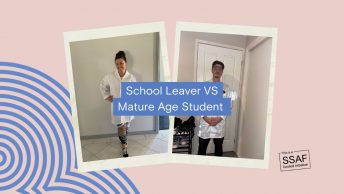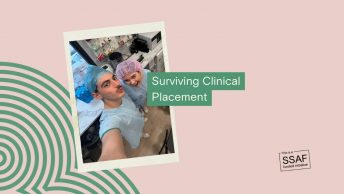This post is over three years old, the information may be outdated.
We are spending so much time in front of technology these days. Suddenly, we have the freedom to learn on the couch, in bed, on a chair, lying on the ground even.
You might not be aware that working in an unhealthy position or doing unhealthy practices while studying can do you real harm. Or you may have felt the strain of studying, such as headaches, a sore back or sore eyes. And no one wants to feel the strain while studying.
So while we all study online for the time being, for some up to 8 hours in screen-based classes 4-5 days a week (and that’s even before studying content from those classes!!), here are some things you should pay attention when your heads are in the books, or in this case, glued to a computer screen.
Use the right chair
Swivel chairs are often the most common chairs that people use to study. After all, they can slide under a desk very easily (and you can roll around on them until your heart is content). But they have little support for your back making a good posture almost impossible. A solid chair with good back support has been shown to be better for sitting for long periods of time.
Shine the light
If you are studying during the day, find some natural light to help you be productive. Studies have shown that students learn better in natural light and that it also can lift your spirits. Additionally, having a good source of light gives your eyes an easier time of absorbing the information you are learning, lessening the chances of sore eyes at the end of a marathon study session. Make sure that there is enough light to help you get that crucial light-bulb moment while studying.
Don’t be a slouch
Slouching in your chair puts more pressure on the discs and vertebrae of your back, which is not good news at all. Try and use the lumbar support in your chair and avoid sitting in a way that places body weight on one area than others. Additionally, make sure you are positioned as close to your workstation as possible to avoid reaching for equipment and your work.
Look straight ahead
Don’t work on an angle. Make sure you are looking directly at your work, rather than to the side or up and down. Your neck and head can get worn out if you are having to turn it very often. But make sure your work is not too close, especially a computer monitor. To avoid eye strain, keep at least an arms length away.
Take a break
Given you are working for a long period of time, remember to take breaks to keep your body and mind fresh. Aim for breaks of around 10-20 minutes and if you can, get moving to get rid of any tiredness and stiffness. Maybe you could take a power nap or meditate or do another activity. Doing a different task while you take a break from studying may use different parts of the brain, such as running some errands or doing some cleaning.
With these tips, studying for longer will be a breeze, or at least a little easier than before. Good luck this new semester in your studies.










